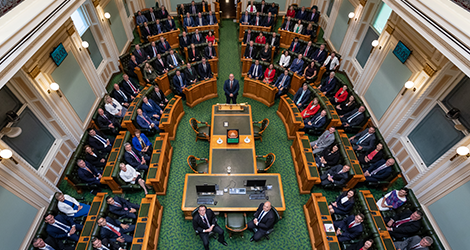The government’s recently to “transform maths education” have set off a heated debate over how the subject is taught in classrooms.
Authors
David Pomeroy
Senior Lecturer in Mathematics Education, University of Canterbury
Lisa Darragh
Lecturer in mathematics education, Faculty of Education and Social Work, University of Auckland, Waipapa Taumata Rau
Primary and intermediate schools will now have a new maths curriculum starting in 2025 – a year earlier than initially planned – based on “structured maths”.
Unlike structured literacy, which has a broad research base, structured maths is .
From what Education Minister Erica Stanford and her have said, it’s likely structured maths will include teachers directly explaining maths to children before they practise it, children repeating maths techniques until they have mastered them, and more rote memorisation of basic facts like times tables.
During last year’s election, łÔąĎÍřŐľ campaigned on a policy to ““. Students are now required to have one hour of maths per day in Years 1-8 and twice-yearly standardised maths tests in Years 3-8 from 2025.
But the government’s latest announcement has a new tone of urgency – which raises some questions.
Misleading numbers
Prime Minister Christopher Luxon called “appalling” and a “total system failure”. Stanford “those statistics tell us there’s no time”.
The government using a study that found just 22% of Year 8 students, and just 12% of Māori students, were at the expected curriculum benchmark for mathematics. Taken out of context, these figures clearly paint a grim picture.
But in reality, a change in curriculum and a new benchmarking process introduced by the previous government in 2023, rather than a change in achievement.
As , one of the lead researchers involved in the study quoted by the government:
We’ve been tracking student achievement in mathematics at Year 8 for more than ten years, and in that time, there has been no evidence for improvement or decline. We do have a new draft curriculum, however, and the provisional benchmarking exercise we carried out indicates it requires a higher level of proficiency than the 2007 curriculum.
The Aotearoa Educator’s Collective has on this misleading use of statistics.
The problem with rushing change
Primary maths education has been and does need support. But the government appears to be manufacturing a crisis to justify rushing the changes.
The structured maths curriculum and teaching resources are still being developed and time is running out.
Having these resources in teachers’ hands in time for 2025 will mean important processes, including consultation, quality control of resources and teacher professional learning, will be very rushed – if they happen at all.
This pace is concerning. Teachers are already under pressure to implement other mandatory changes in assessment and literacy.
Educators need resources directly connected to the curriculum and relevant to the children in Aotearoa New Zealand. Rushing the process means neither of these are likely to be the case.
Stanford is in with existing providers to create these resources, yet these providers will also be operating on a rushed time frame.
They may not be able to provide something that is deeply connected to the curriculum, perhaps instead reframing existing material that is only superficially related.
Another option the minister might consider is to import overseas resources. This approach is also problematic. Resources made outside Aotearoa New Zealand do not reflect the diversity of our classrooms. For mathematics to be relevant for all children, resources should be locally focused.
Lack of research for new curriculum
At a surface level, the proposed new maths teaching methods have appeal. But research supporting this change is . Even the ministerial advisory group the research base for structured maths is “not as clear cut as the research for literacy”.
According to a from the advisory group, “applying general principles from cognitive psychology to mathematics suggests that these (structured maths) practices will improve teaching”. But general principles suggesting an approach might work do not justify a rushed system overhaul.
Of course cognitive psychology, which includes topics like repetition and memory, is relevant to maths learning. However, cognitive theories of learning are only one part of the complex activity of classroom teaching.
Time to slow down
The limited evidence for structured maths stands in stark contrast to the broad base of showing how to engage children in cognitively rich, creative and culturally-relevant maths.
While the government’s crisis narrative is unhelpful, there is a need and a political mandate for more support in maths education.
But what the country requires is a slow and considered response that is likely to work for the children and teachers it serves.
Rushing through a model with a weak evidence base only adds to teachers’ workloads, without guaranteeing to deliver the “brilliance” teachers and parents have been promised.
![]()
David Pomeroy receives funding from the Teaching and Learning Research Initiative (TLRI).
Lisa Darragh receives funding from Royal Society Te Apārangi Marsden Fast Start Grant







